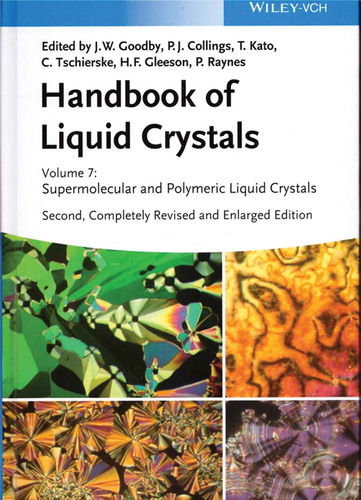With volume 7 of the Handbook of Liquid Crystals, we are now leaving the world of small molecule systems, arriving at supermolecular and polymeric liquid crystals. This especially includes liquid crystalline structures in biological systems. This first part of the volume is started by Sharon Jewell, who summarises the role of liquid crystals in living systems and the development of life. The chapter discusses self-assembly in living systems, especially also that of DNA, the formation of spider silk from liquid crystalline systems, membranes and the relation of their structure to diseases, the biophysics of lipid membranes, their elasticity, mechanics and flexoelectricity.
Biomembranes is the following chapter by Linda Hirst, who reports on cell membranes, lipids and their phase diagrams, curvature and the relation to living cells. Cellulosic liquid crystals are the natural polymeric liquid crystals discussed by Peter Zugenmaier. These form chiral nematic phases and investigation methods are pointed out; models of the phase structure are discussed, together with mesophase formation mechanisms. Further, the physical properties of cellulose liquid crystals are summarised, optical properties, structural handedness, temperature and concentration dependence and solvent effects pointed out. These are lyotropic systems, but also thermotropic behaviour is discussed. Unfortunately, it appears that this chapter is a reprint from the earlier edition.
At last, John Lydon contributed Chapter 4, which provides an interesting overview of silk, fibres and collagen and their relation to liquid crystals. The chapter covers the historic aspects and some of the chemistry, structures and textures. Silk is discussed via different materials such as silkworm silk and spider silk, while their physical properties, production and commercial use are highlighted. Similarly, collagen and bone are introduced.
Part 2 of the volume is related to dimesogens, oligomesogens and dendrimers. Corrie Imrie and Geoffrey Luckhurst introduce dimers and oligomers with liquid crystalline properties in Chapter 5 via structure–property relationships and the odd–even effect. Smectic phases are not only discussed from their conventional structure, but also as intercalated structures and modulated phases. Different molecular shapes are then introduced, chiral dimers, H- and T-shaped mesogens, bent-core-based materials and discotics, biaxial and twist-bend nematics.
Chapter 6 by Isabel Saez is related to a discussion of supermolecular liquid crystals, their structure and phases, and different examples from chiral materials, Janus molecules and functional materials. Silvia Hernandez-Ainsa, Mercedes Marcos and Jose Luis Serrano report on dendrimeric and hyperbranched liquid crystal structures in the following chapter, Chapter 7. These are mainly side-chain liquid crystal dendrimers, main-chain dendrimers and hyperbranched liquid crystal polymers, with a range of different examples presented. Also, potential applications of dendrimers are discussed.
Part 3 then covers the main-chain and side-group thermotropic polymers with Andreas Greiner and Hans-Werner Schmidt contributing Chapter 8 about aromatic main-chain polymers. After a general introduction and structural concepts, a variety of polyesters are discussed with different substituents. Joachim Wendorff wrote Chapter 9 on the main-chain and side-group polymers with discotic units, including cross-linked materials. Thermotropic ridged-rod polysilanes are the topic of Chapter 10 by Junji Watanabe, who touches on the phase behaviour, smectic structures and binary mixtures of polymers with different molecular weights.
Continuing with liquid crystalline side-group polymers, Seiji Ujiie and Takashi Kato introduce more chemistry and synthesis in Chapter 11, where different polymerisation mechanisms and reactions are outlined, as are the influence of spacer and polymer backbone, terminal groups and mesogenic cores. Synthetic methods are exemplary demonstrated for polymethacrylates and polysiloxanes. Seiji Ujiie and Hiroshi Orihara then point out some of the different structure property effects in relation to side-group polymers, like phase transitions, field induced effects, electro-rheological effects, electric and dielectric properties, as well as ferroelectric properties and switching.
The next chapter by Zhihao Shen and Qi-Feng Zhou, Chapter 13, progressively complicates the polymer structures to side-on type side-group polymers and combined main-chain/side-group polymers. Molecular design, synthesis and characterisation techniques, such as polarised light microscopy, differential scanning calorimetry, X-ray and neutron scattering, are discussed. Properties and applications are pointed out.
Part 4 is entitled Block Copolymers and Polymer Networks and contains the last three chapters of the volume. Starting with Liquid Crystal Polymer Networks, Chapter 14 by Danqing Liu, Cees Bastiaansen and Dirk Broer provides the foundations of thermally responding liquid crystal networks and light-triggered actuators, representing systems which have gained increasing interest over the last years. This chapter could have possibly been a bit more elaborate, discussing the stabilisation of phases through polymer networks and the effect of phase separated polymer networks on the physical properties of liquid crystals. In general, I was also missing a discussion of polymer disperse liquid crystals, which have gained applicational impact through privacy windows for example.
Chapter 15 by Hong Yang, Zi Liang Wu and Patrick Keller elaborates on liquid crystalline elastomers. Various aspects are discussed, such as the preparation of elastomer polydomain samples, the effect of solvents, monodomain samples, orientation by stress and magnetic fields, or photoresponsive azo-based systems.
The last chapter, Chapter 16, on block copolymers was written by Olli Ikkala, Nikolay Houbenov and Patrice Rannou. It covers block copolymers from diblock structures, self-assembled hierarchies, multicomponent systems and self-assembly involving biological structures.
Volume 7 of the Handbook of Liquid Crystals series thus covers a comprehensive and relatively concise overview of polymer-related liquid-crystalline structures on a total of about 600 pages. From the well-known main-chain and side-group polymers, to the more recent polymer networks and elastomers, all the way to biologically inspired systems. Synthesis as well as physical properties and applications are discussed. This is certainly the volume that should be available as a reference work for every liquid crystal polymer chemist and physicist.

